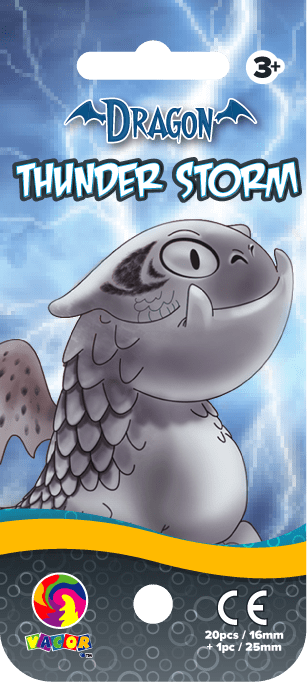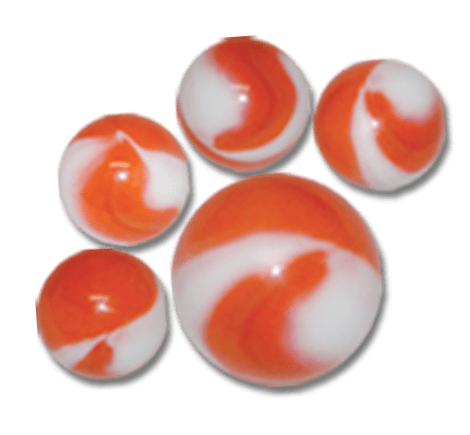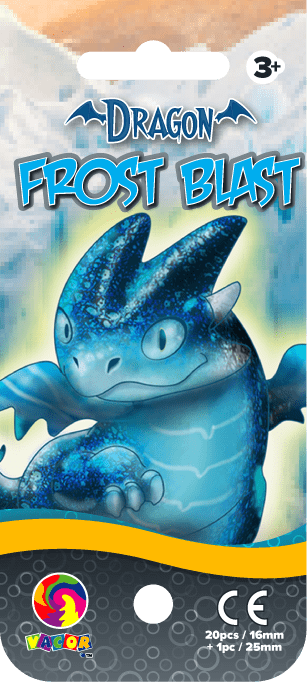
dragon
We all know that a Dragon is a long serpentine, legendary creature that appears in the folklore of many cultures worldwide. Beliefs about dragons vary considerably through regions, but dragons in western cultures since the High Middle Ages have often been depicted as winged, horned, four-legged, and capable of breathing fire. Dragons in eastern cultures are usually depicted as wingless, four-legged, serpentine creatures with above-average intelligence. But what happens if we join the dragons and the marbles? Result a mixture of legendary marbles!


thunder storm
Tyrannosaurus was a large predatory dinosaur from the Upper Cretaceous, 68 to 66 million years ago. Tyrannosaurus was a bipedal carnivore with a massive skull balanced by a long, heavy tail. Compared to the large and powerful hind limbs, its forelimbs were small, but powerful for their size. They had two clawed digits. There is discussion as to whether it was a hunter or a scavenger. Like most dominant meat-eaters of today, such as lions and hyenas, Tyrannosaurus might have been both. It had a very strong jaw, and its bite power could snap the bones of other dinosaurs. More than 30 specimens of Tyrannosaurus rex have been found. Some of them are nearly complete skeletons, and soft tissue and proteins have been reported in at least one of these specimens. Research is done on its biology, life history and biomechanics. The feeding habits, physiology and potential speed of Tyrannosaurus rex are some topics. Some scientists think Tarbosaurus bataar from Asia is a second species of Tyrannosaurus, but others think Tarbosaurus is a separate genus.


frost
blast
Spinosaurus (which means 'spiny lizard') was a huge semi-aquatic dinosaur from the Cretaceous, 112 to 97 million years ago. It had paddle-like feet and nostrils on top of its crocodile-like head. This would let it submerge as a crocodile does. The same research suggests it was perhaps larger than Tyrannosaurus rex, but more clumsy on land, moving as a quadruped. All these ideas had been suggested before. The discovery of a more complete skeleton made palaeontologists think they were correct. The fossil was found in Morocco by a private collector who let scientists examine it. Spinosaurus bones were first discovered in Egypt in 1912 by German paleontologist Ernst Stromer in 1915. Two species, S. aegyptiacus and S. marocannus, are recognized by many paleontologists, but there may only be one. Spinosaurus looked like Baryonyx except it was larger and more heavily built. Six specimens of Spinosaurus have been uncovered. Apparently, good material was destroyed in a WW2 bombing raid.


fire
blaze
Triceratops was a huge herbivorous ceratopsid dinosaur from the late Cretaceous. Its name came from having three horns on its head. They were mainly found in North America. As adults, they grew up to 30 feet long by 9 feet tall (9.1 × 2.7 m), and probably weighed around 5,400 kg (12,000 lb). Triceratops was a low browser with a bony beak in front of its jaws. The jaws had close-set grinding teeth. Its defence had to stand up to attacks from taller theropods, hence the bony shield which covered its neck. Holes made by teeth have been found on the bony frill behind the horns, and on the sacrum (the part of the spine above the pelvis). Many fossils of Triceratops have been collected since the genus was first described in 1889. There is at least one complete individual skeleton. Paleontologist John Scannella observed: "It is hard to walk out into the Hell Creek Formation and not stumble upon a Triceratops weathering out of a hillside". Forty-seven complete or partial skulls were discovered in just that area during the decade 2000–2010. Specimens showing life stages from hatchling to adult have been found.


earth-
quake
Pterodactylus (meaning "winged finger") is an extinct genus of pterosaurs, whose members are commonly known as pterodactyls. It is thought to contain only a single species, Pterodactylus antiquus, the first pterosaur species to be named and identified as a flying reptile. The fossil remains of this species have been found primarily in the Solnhofen limestone of Bavaria, Germany, dated to the late Jurassic Period (early Tithonian), about 150.8–148.5 million years ago, though more fragmentary remains have been tentatively identified from elsewhere in Europe and in Africa. It was a carnivore and probably preyed upon fish and other small animals. Like all pterosaurs, Pterodactylus had wings formed by a skin and muscle membrane stretching from its elongated fourth finger to its hind limbs. It was supported internally by collagen fibres and externally by keratinous ridges.











